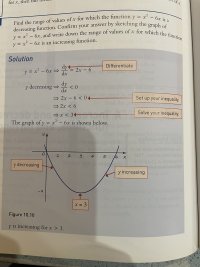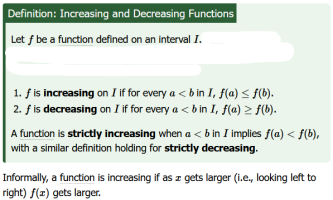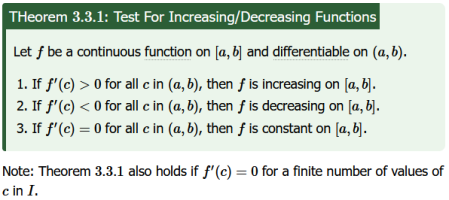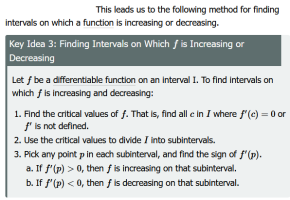At the risk of creating another fight... i think i will try and summarise what i have learnt (!), thinking about my original post:
Using the fundamental definitions from algebra ( wolfram source) f(x)=x^3 is an strictly increasing function ( but not just increasing) for all values of x
Strictly increasing implies increasing. "Increasing at" doesn't make any sense. Increasing implies that a comparison before-after took place. This requires two points for a comparison.
If you talk about a point where the first derivative vanishes, then it is just that: the first derivative is zero. It has nothing to do with monotone behavior. [imath] g(x)=x^2 [/imath] and [imath] f(x)=x^3 [/imath] have both vanishing derivatives at [imath] x=0. [/imath] However, [imath] g(x) [/imath] turns from strictly decreasing to strictly increasing in a neighborhood of [imath] x=0 [/imath] whereas [imath] f(x) [/imath] remains strictly increasing.
But using the tool of derivatives, f(x)=x^3 is increasing for all values except x=0
No. See my comment above. The two terms "increasing" and "derivative" have nothing directly to do with each other. There are two theorems that connect the two, but they are irrelevant here.
1.) If a function has a local extremum, minimum or maximum, then the derivative - so the function is differentiable - vanishes there. As you can see, [imath] g(x) [/imath] instantaneously switches from strictly decreasing to strictly decreasing at its local maximum, but that does not mean that you can speak of "increasing" or "non-increasing" "at". [imath] f(x) [/imath] has also a vanishing derivative at [imath] x=0 [/imath] but it has no local extremum there and keeps being strictly increasing.
A local extremum of a differentiable function switches from decreasing to increasing like [imath] f(x) [/imath] or the other way around like [imath] -f(x) [/imath] would do. But that doesn't mean you can speak of monotone behavior "at". We need a comparison of two arbitrary points and their function values. The derivative only allows us in a very limited sense to make statements about function values.
2.) If, and this is a crucial condition,
if a function is differentiable at [imath] x=x_0 [/imath]
and its derivative [imath] f'(x) [/imath] is continuous at [imath] x=x_0 [/imath]
and its derivative at [imath] x=x_0 [/imath] is positive, say [imath] f'(x_0)=c>0 [/imath] then [imath] f(x) [/imath] is strictly increasing in a neighborhood around [imath] x_0. [/imath] This is a
local statement about an area of the domain where [imath] f'(x)>0. [/imath] Such a neighborhood can actually be very small and does not allow any global statements. Continuity of [imath] f'(x) [/imath] guarantees that [imath] f'(x)>0 [/imath] a little bit left and a little bit right from [imath] x_0. [/imath] Within this neighborhood of [imath] x_0 [/imath] we have a positive slope and thus an increasing function.
If you want to use this for the entire domain, you have to patch all these neighborhoods. That will only work if [imath] f'(x)>0 [/imath] on the entire domain. Hence a point with [imath] f'(x_0)=0 [/imath] makes this criterion inapplicable: the argument does not work anymore. The fact, that the argument does not work anymore cannot be used to conclude anything. E.g. [imath] g(x)=x^2 [/imath] changes its behavior at [imath] x=0 [/imath] whereas [imath] f(x)=x^3 [/imath] does not change its behavior. A conclusion by using the derivatives is no longer possible. And the examples show that both outcomes are possible.
By contrast, f(x)= 2x is an increasing function from the definition. It is also increasing from the derivative test.
You better forget the "derivative test". It is confusing, off-topic, and useless if the derivative changes signs or vanishes. It also suggests that monotone behavior and differentiability were connected. They are not. Monotone behavior is defined by pure comparison of two values [imath] f(x) [/imath] and [imath] f(y) [/imath] where [imath] x>y. [/imath] A function doesn't even need to be continuos, let alone differentiable to be monotone increasing (or decreasing). The function
[math] x \longmapsto \begin{cases} 2x &\text{ if }x>1\\2x-2&\text{ if }x\leq 1 \end{cases} [/math]is strictly monotone increasing but not even continuous.
However, f(x)= 4 ( say) is also an increasing function (!), from definitions) but neither from the derivative test.
It is monotone increasing since [imath] 4=f(x)\geq f(y)=4 [/imath] for all [imath] x>y. [/imath] Note that it is monotone decreasing, too, by the same argument. However, it is not strictly monotone increasing since [imath] 4=f(x)\not\gt f(y)=4 .[/imath]
Again, forget the derivative. You need continuous differentiability and a strictly positive (or negative) derivative everywhere only to conclude the obvious.
I am aware that perhaps oversimplifies it...
I think i also didn't appreciate that the derivatives approach was not the definition of increasing/decreasing. I assumed it was. ( the textbook i used defined increasing/decreasing in terms of derivatives)
The reason why I am (strictly) opposing to connect differentiability and monotone behavior has a deep-reaching reason!
Monotone behavior is a global statement. It is a statement about a part of the domain, not necessarily the entire domain, but nevertheless a global statement, in the sense of not being local.
Differentiability is a local phenomenon. It is a statement about a location and its direct neighborhood. E.g. [imath] x\longmapsto 1/x [/imath] is differentiable at [imath] x=0.00000000000000000000001 [/imath] but this ranges only [imath] 0.000000000000000000000009999... [/imath] to the left before it becomes not differentiable. This is very local and far from comparing the function at two different points.
If you want to connect local and global behavior, you will find yourself right at the center of differential geometry where those local neighborhoods are patched to make a global statement.
To answer your original question:
a) Forget the phrase "increasing at".
b) Forget differentiability.
c) Say we have [imath] x>y [/imath] and [imath] x=y+c [/imath] for some positive number [imath] c>0. [/imath] Then
[math]
f(x)=x^3=(y+c)^3=y^3+3yc^2+3y^2c+c^3=y^3+3yc(c+y)+c^3=y^3+3xyc+c^3
[/math]The RHS is greater than [imath] f(y)=y^3 [/imath] if [imath] x [/imath] and [imath] y [/imath] have the same sign. Let us assume that [imath] y<0 [/imath] and [imath] x>0. [/imath] In this case [imath] f(x)=x^3>0>y^3=f(y), [/imath] too. Hence [imath] f(x)>f(y) [/imath] in all cases and [imath] f(x)=x^3 [/imath] is strictly increasing. We don't need a derivative and have covered the entire domain without bothering the vanishing slope at [imath] 0. [/imath]
For the case you insist on using the derivative to answer such questions about monotony, make sure the derivative is continuous and has no zeros anywhere. Otherwise, it cannot be used to make
any conclusion.






